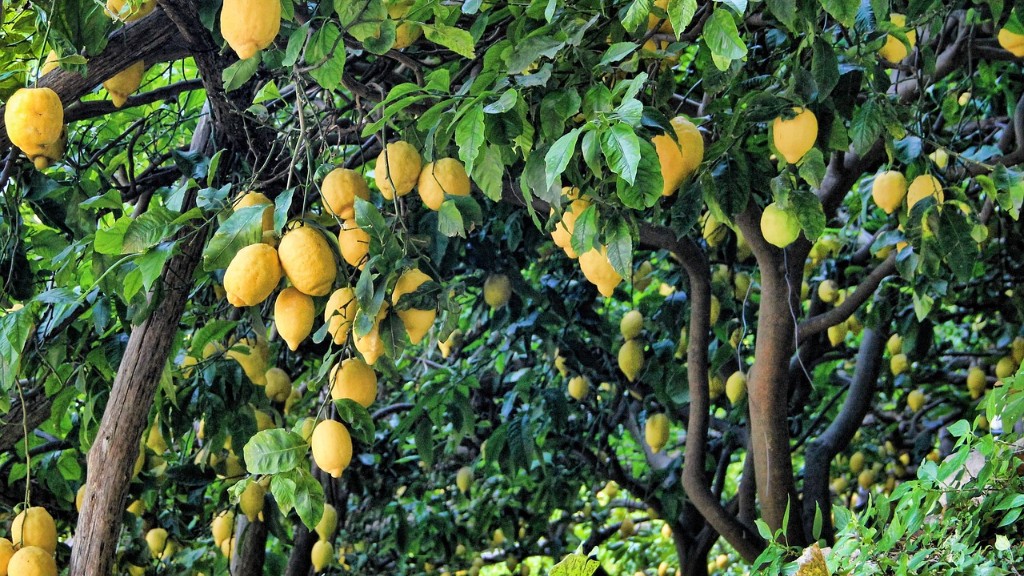Growing a lemon tree is easy and rewarding. With the right strategy, you can have a surprisingly bountiful harvest. Here’s the step-by-step guide to learn how to plant and grow a lemon tree:
First and foremost, pick out a suitable space. If planting outdoors, pick a sunny location. If planting indoors, look for a spot that gets a fair amount of sun and has good air circulation. Make sure the space is at least 6 feet high and at least 4 feet wide.
Next, purchase a healthy lemon tree. When shopping for a healthy lemon tree, look for lemon tree saplings that have glossy green leaves and firm branches with no visible signs of disease. Avoid choosing saplings that are mushy, withered, or sold in a burlap bag.
Thirdly, prepare the soil. Lemon trees need fast-draining, nutrient-rich soil to thrive. To prepare the soil for planting, dig down deep and add organic compost, aged manure, and dried leaves. Also, add a general-purpose fertilizer to provide long-term nourishment.
The fourth step is to plant the tree. Start by digging a hole deep enough to accommodate the lemon tree sapling and its rootball. Gently place the sapling in the hole, and refill the soil around the base of the tree. Water the tree well and spread a layer of mulch around it to retain moisture.
The fifth step is to install a stake to provide support. Lemon trees need support while they’re growing to keep them from bending as they become top-heavy with fruit. Install a stake at least 8 feet tall and secure it above the rootball with rope or string.
Last but not least, prune the lemon tree. Careful pruning can help your tree branch out and produce more fruit. Prune any dead wood or shoots coming from the ground. Eventually, these shoots will form part of the main lemon tree trunk and branches, so do not remove them altogether.
Lemon Tree Care
Now that you know how to plant and grow a lemon tree, it’s essential to know how to properly care for it. To help your lemon tree to thrive, it’s important to follow proper watering and fertilizer schedules that suit the local climate.
In general, lemon trees favor regular, deep watering once or twice a week. Avoid letting the soil dry out completely. During hot summer periods, you may need to water more frequently. When fertilizing, use a slow-release fertilizer preferably one tailored to citrus trees.
Keep an eye out for any pest infestations like thrips, mealybugs, and scale insects. If noticing any pests, treat them quickly with insecticidal soap or other organic insect sprays. Inspect the leaves regularly, looking out for signs of nutrient deficiency like leaf yellowing and brown spots.
Finally, to ensue a bountiful harvest, make sure to harvest the fruit when ripe. In general, lemons change their color from green to yellow as they ripen, and the lemons should be picked before they begin to soften. Harvesting ripe lemons prevents them from falling prematurely, and it also allows for improved pest control.
Enhanced Lemon Tree Care
For an extra bit of care for your lemon tree, consider several enhanced or supplementary methods. For example, try netting the tree to protect it from birds. Alternatively, practice companion planting – planting other plants near your lemon tree that improve health, attract beneficial insects and repel pests. Good companion plants are marigold, garlic, and lavender.
In the winter season, keep an eye out for frost. Make sure the tree has some frost protection, such as a sheet of fabric, to prevent the branches from succumbing to the cold temperatures. Additionally, you can use frost protection sprays containing anti-cold ingredients, such as sugar and alcohol.
Finally, consider pruning the lemon tree regularly. Pruning is essential for controlling the size and shape of the lemon tree, improving air flow and preventing fungal diseases. Remember to always make all cuts clean and quick, starting a couple of inches above a bud near the center of the branch.
Tips and Tricks for Growing a Lemon Tree
When growing a lemon tree, there are several handy tips and tricks to keep in mind and ensure a successful outcome. For instance, make sure to feed the lemon tree regularly and use liquid seaweed fertilizer once a month, as these will encourage growth and promote fruit production.
Another useful trick is to eliminate fruit early on in the growing process. Removing a few fruits from the lemon tree during the first few months of growth can help it to focus its energy on other important tasks like developing branches, leaves and root systems.
If planting a lemon tree indoors, make sure to provide it with a steady supply of light. Place the lemon tree in a south-facing window where it can receive ample sunlight and use supplemental lighting, such as fluorescent lights, to get the best results.
Furthermore, it’s essential to pay attention to the soil pH. Lemon trees favor soil that’s slightly acidic, between 6 and 7 on the pH scale. If the pH level comes out as too alkaline, add sulfur to the soil to lower the pH.
Finally, use a good-quality potting mix created specifically for citrus trees to get the most out of your tree. Such potting mix contains ingredients like pumice, perlite, coco coir and high-quality compost that help to make sure the tree stays healthy and strong.
Citrus Diseases and Pests Prevention
To prevent any citrus diseases or pest infestations, make sure to follow good lemon tree growing practices. First and foremost, avoid overwatering or underwatering your tree. Stick to a regular watering routine that suits your local climate, and make sure the soil is not soggy or overly wet at any point.
In the same vein, avoid planting your lemon tree in a space with poor drainage. When planting, consider installing a raised bed or add drainage materials such as perlite or clay to the soil to ensure good drainage.
When temperatures drop, watch out for frost and take appropriate precautions, such as using strong frost protector sprays. Additionally, keep the tree away from any areas with strong wind as this can damage developing lemon fruits.
Finally, if dealing with any pest infestations, use organic products to solve the problem. Insecticidal soaps, neem oil, and natural insecticides like pyrethrin and cinnamaldehyde can be used to treat the pest problem without damaging the tree.
When to Harvest Lemons
When it’s time to harvest lemons, there are a few definite signs to look out for. For example, watch for lemon fruits that are plump and full and have changed color from green to yellow. The size and color should be uniform across all fruits.
Although the lemons should still be firm, they should be slightly soft when gently squeezing them. Also, lemons should smell fragrant when their skin is gently rubbed. If noticing any of these signs, it’s time to harvest the lemons.
In addition, consider the position of the fruit. If the lemon has started to sag from the top of the tree, it’s a sign that it’s touching maturity. Also, check the leaves near the fruit. If seeing any yellowing near a fruit, it’s likely ripe and ready to be harvested.
Finally, pay attention to the time of year. If it’s late summer or early fall, harvest the lemons even if they have not yet reached maturity. This helps to safeguard the fruits and ensures their quality. If picking lemons at their peak, use a pair of scissors to snip them off the twig, leaving some bit of stem attached.



